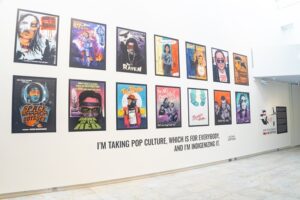Anishinabek citizens highlight the importance of representation

By Rick Garrick
LONDON, ONTARIO — Chippewas of the Thames’ Jay Soule and Alderville’s Sara Mai Chitty recently highlighted the importance of representation during the Seeing Red: Jay Soule In Conversation with Sara Mai Chitty webinar on Jan. 12. The event was held by Words The Literary and Creative Arts Festival and Museum London to mark the closing of Museum London’s Seeing Red: Movie Posters Indigenized by CHIPPEWAR exhibition, which ran from April 20-Jan. 12 featuring a selection of Soule’s posters that satirized blockbuster movie classics with the aim of exposing and criticizing the enduring legacy of colonialism in Canada.
“I’ve been doing these sort of movie posters for more than 10 years and other than shows I’ve kind of curated and put together myself or art fairs I’ve participated in myself, I’ve had a really difficult time getting this work out into the public,” says Soule, whose artist name is Chippewar. “Traditional institutions like museums and galleries, when you tell them you’re an Indigenous artist, there’s this kind of preconception of what sort of work that you do so this has sort of blocked me in a lot of ways from getting this work out into the world.”
Soule says the posters are very multi-layered in terms of not just being about lack of representation.
“It’s about the misrepresentation but it’s also just a way of me channelling some of my creativity,” Soule says. “I’ve been a movie freak since I was a little kid, I’ve loved pop culture since I was a little kid, so these works are really representations of what I learned growing up about Indigenous culture, which is very little, and then as I’ve been on this journey of self-education. It’s been how do I take what I’ve learned and infuse it with a pop culture twist as a means of really meeting all audiences because my work can be viewed from anyone from around the world because we all know these movies.”
Soule says he starts with a catchy name during the creation process for his posters.
“Then I work kind of backwards on that in thinking about what images should go,” Soule says. “Sometimes it’s just storytelling, sometimes it’s funny, sometimes it’s meant to be edgy, sometimes it’s meant to upset people and make them think, but really at the end of the day I’m doing it for myself on my own healing journey and a way to reconnect with culture. That’s really the idea behind the work, the lack of representation, misrepresentation, and then just doing it for fun and doing it for myself.”
Chitty, curriculum and pedagogy advisor for Indigenous Initiatives at Western University, says the concept behind Soule’s posters was about re-envisioning and Indigenizing famous movies.
“So envisioning maybe an Indigenous narrative or Indigenous characters within them to critique representation in pop culture and contemporary mainstream entertainment media,” Chitty says, noting that the posters were quite large and the first artwork that people saw upon entering Museum London. “I feel like behind each one is an entire new movie that I start creating in my head.”
Chitty adds that many of the posters were about science fiction and dystopian movies.
“I don’t know if anyone in the audience has read Waubgeshig Rice’s Moon of the Crusted Snow, but in that novel and this is a concept I’ve heard from many different Indigenous people about how Anishinabek were not unfamiliar to dystopias or apocalypses,” Chitty says.
An edited version of the Seeing Red: Jay Soule In Conversation with Sara Mai Chitty webinar is posted online at the Words Festival’s YouTube page.

